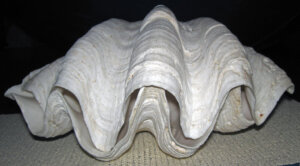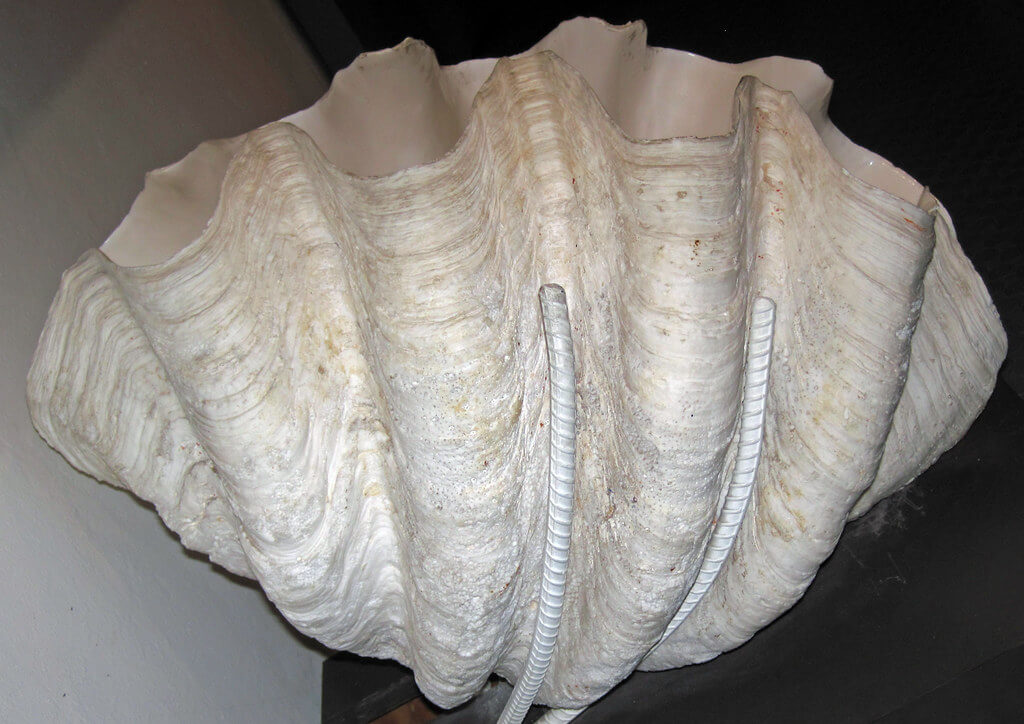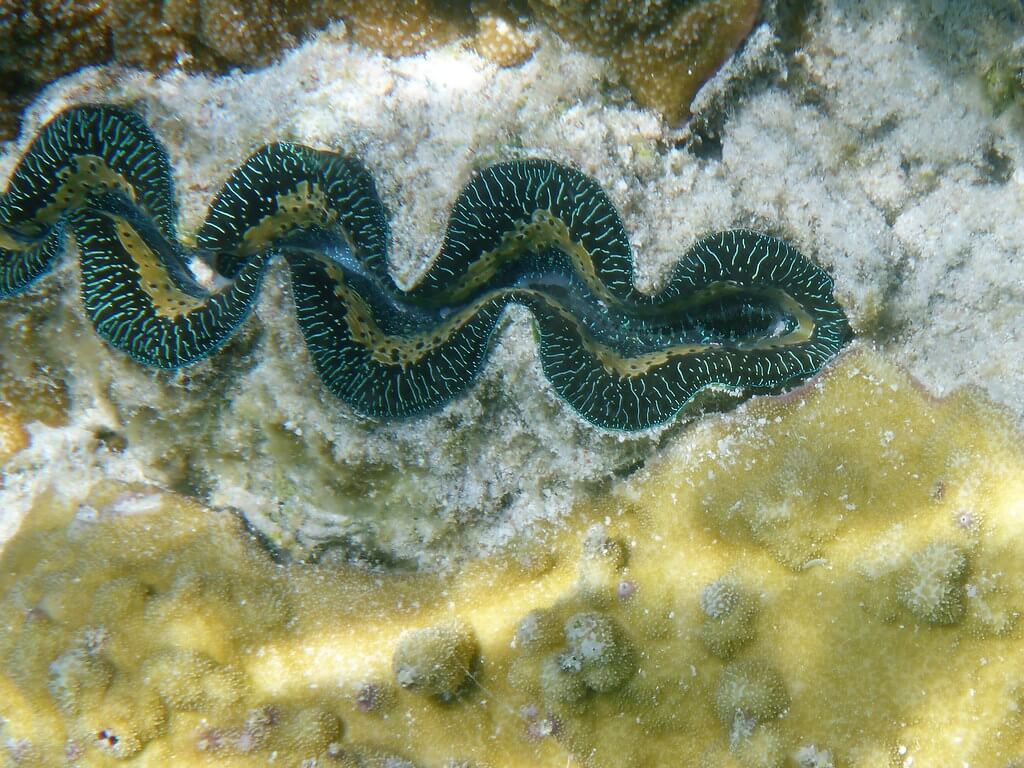5 Curious Facts About the Giant Clam


Written and verified by the biologist Cesar Paul Gonzalez Gonzalez
The giant clam is a peculiar, large species that lives in the depths of the Indo-Pacific Ocean. Although its shell is ostentatious, its physical characteristics are quite similar to the rocky or coral environments of the area. For this reason, it’s normal for it to go unnoticed by inexperienced divers.
The scientific name of this species is Tridacna gigas. It belongs to the Cardiidae family, a group of mollusks known for the shape of their shells and for containing edible specimens among their ranks. Continue reading this space and discover some curious facts about the giant clam.
What is the giant clam like?
The giant clam is one of the largest bivalves in the world, as it can measure up to 1.5 meters (nearly 5 feet) in length and weigh up to 200 kilograms (440 lbs). Even though its shell is the hardest and most robust part of its body, the mantle (the inner part of the clam) also becomes more fleshy as it grows.
This species has a series of indentations or grooves along its shell that end up forming triangles at the edges. Although the outer surface of its shells is colorless, various types of bacteria and algae grow on it. As a result, the coloration varies greatly in each specimen.

Little-known facts about the giant clam
The giant clam isn’t only huge, but also has some curious facts about its biological makeup. Learn the most interesting ones below.
1. They take about 10 years to reach their maximum size
To increase their size, clams need to accumulate enough calcium carbonate, an essential component of their shell. This process isn’t as fast as one might think, as it takes this species between 8 and 12 years to reach 1.5 meters in length.
Bivalve shells are composed of several interwoven layers of calcium carbonate and viscoelastic proteins. To obtain a high resistance like that of the giant clam, these components must be arranged in a complex and precise manner, which entails a high energetic and metabolic expenditure. This is the reason why growth takes so long.
2. The mantle of the clam is usually colorful and showy
In contrast to its valves, the internal part of the giant clam (mantle) can have iridescent colorations such as blue, purple, yellow, and green. These shades are the result of the combination of iridophores and the endosymbiosis they form with zooxanthellae.
The mantle of the giant clam is able to host photosynthetic microorganisms that show bright colors (zooxanthellae). These creatures share the nutrients they produce with the mollusk, while receiving a home and protection in return. In this way, both benefit from their presence and tend to prefer to form a symbiosis.
3. They can suffer from bleaching
As with some coral species, giant clams can suffer from bleaching of their mantle. This means that it becomes pale and loses most of the iridescent colors that characterize it.
Bleaching is actually a response to environmental stresses caused by changing temperature or water composition. When faced with such scenarios, the clam releases or eliminates the zooxanthellae it harbors in its mantle, resulting in the loss of the bright hues.
4. Adults don’t have a byssal gland
Several bivalves have byssal glands that synthesize sticky substances to adhere to the substrate. Although giant clams have them in their juvenile stages, when they become adults they lose their functionality. This isn’t a problem for the specimens, as, thanks to their weight and size, they’re unlikely to move from place to place.
5. It’s classified as a vulnerable species
According to the International Union for Conservation of Nature, the giant clam is a vulnerable species, whose population seems to be in decline. Although there are several techniques to reproduce it in captivity, specimens reach sexual maturity at 9 to 10 years of age. Therefore, it’s difficult and time-consuming to establish recovery and reintroduction strategies.

As you can see, the giant clam doesn’t only have a showy appearance, but also holds several curious secrets about its natural history. However, there’s still a lot more information to discover, and so it’s quite possible that in the future it will surprise us with other enigmatic and fascinating characteristics.
The giant clam is a peculiar, large species that lives in the depths of the Indo-Pacific Ocean. Although its shell is ostentatious, its physical characteristics are quite similar to the rocky or coral environments of the area. For this reason, it’s normal for it to go unnoticed by inexperienced divers.
The scientific name of this species is Tridacna gigas. It belongs to the Cardiidae family, a group of mollusks known for the shape of their shells and for containing edible specimens among their ranks. Continue reading this space and discover some curious facts about the giant clam.
What is the giant clam like?
The giant clam is one of the largest bivalves in the world, as it can measure up to 1.5 meters (nearly 5 feet) in length and weigh up to 200 kilograms (440 lbs). Even though its shell is the hardest and most robust part of its body, the mantle (the inner part of the clam) also becomes more fleshy as it grows.
This species has a series of indentations or grooves along its shell that end up forming triangles at the edges. Although the outer surface of its shells is colorless, various types of bacteria and algae grow on it. As a result, the coloration varies greatly in each specimen.

Little-known facts about the giant clam
The giant clam isn’t only huge, but also has some curious facts about its biological makeup. Learn the most interesting ones below.
1. They take about 10 years to reach their maximum size
To increase their size, clams need to accumulate enough calcium carbonate, an essential component of their shell. This process isn’t as fast as one might think, as it takes this species between 8 and 12 years to reach 1.5 meters in length.
Bivalve shells are composed of several interwoven layers of calcium carbonate and viscoelastic proteins. To obtain a high resistance like that of the giant clam, these components must be arranged in a complex and precise manner, which entails a high energetic and metabolic expenditure. This is the reason why growth takes so long.
2. The mantle of the clam is usually colorful and showy
In contrast to its valves, the internal part of the giant clam (mantle) can have iridescent colorations such as blue, purple, yellow, and green. These shades are the result of the combination of iridophores and the endosymbiosis they form with zooxanthellae.
The mantle of the giant clam is able to host photosynthetic microorganisms that show bright colors (zooxanthellae). These creatures share the nutrients they produce with the mollusk, while receiving a home and protection in return. In this way, both benefit from their presence and tend to prefer to form a symbiosis.
3. They can suffer from bleaching
As with some coral species, giant clams can suffer from bleaching of their mantle. This means that it becomes pale and loses most of the iridescent colors that characterize it.
Bleaching is actually a response to environmental stresses caused by changing temperature or water composition. When faced with such scenarios, the clam releases or eliminates the zooxanthellae it harbors in its mantle, resulting in the loss of the bright hues.
4. Adults don’t have a byssal gland
Several bivalves have byssal glands that synthesize sticky substances to adhere to the substrate. Although giant clams have them in their juvenile stages, when they become adults they lose their functionality. This isn’t a problem for the specimens, as, thanks to their weight and size, they’re unlikely to move from place to place.
5. It’s classified as a vulnerable species
According to the International Union for Conservation of Nature, the giant clam is a vulnerable species, whose population seems to be in decline. Although there are several techniques to reproduce it in captivity, specimens reach sexual maturity at 9 to 10 years of age. Therefore, it’s difficult and time-consuming to establish recovery and reintroduction strategies.

As you can see, the giant clam doesn’t only have a showy appearance, but also holds several curious secrets about its natural history. However, there’s still a lot more information to discover, and so it’s quite possible that in the future it will surprise us with other enigmatic and fascinating characteristics.
All cited sources were thoroughly reviewed by our team to ensure their quality, reliability, currency, and validity. The bibliography of this article was considered reliable and of academic or scientific accuracy.
- Griffiths, D. J., Winsor, H., & Luongvan, T. (1992). Iridophores in the mantle of giant clams. Australian journal of zoology, 40(3), 319-326.
- Norton, J. H., Prior, H. C., Baillie, B., & Yellowlees, D. (1995). Atrophy of the zooxanthellal tubular system in bleached giant clams Tridacna gigas. Journal of invertebrate Pathology, 66(3), 307-310.
- Beckvar, N. (1981). Cultivation, spawning, and growth of the giant clams Tridacna gigas, T. derasa, and T. squamosa in Palau, Caroline Islands. Aquaculture, 24, 21-30.
- Tisdell, C., Lucas, J. S., & Thomas, W. R. (1990). An analysis of the cost of producing giant clam (Tridacna gigas) seed in Australia (No. 1743-2016-140776).
- Maynard, D. M., & Burke, W. (1971). Maximum tension developed by the posterior adductor muscle of the giant clam, Tridacna gigas (Linné). Comparative Biochemistry and Physiology Part A: Physiology, 38(2), 339-350.
- Norton, J. H., & Jones, G. W. (1992). The giant clam: an anatomical and histological atlas (No. 435-2016-33687).
- Buck, B. H. (2000). Experimentally Induced Bleaching and Recovery of Tridacna gigas (Doctoral dissertation, University of Bremen).
- Lin, A. Y. M., Meyers, M. A., & Vecchio, K. S. (2006). Mechanical properties and structure of Strombus gigas, Tridacna gigas, and Haliotis rufescens sea shells: a comparative study. Materials Science and Engineering: C, 26(8), 1380-1389.
- Bonham, K. (1965). Growth rate of giant clam Tridacna gigas at Bikini Atoll as revealed by radioautography. Science, 149(3681), 300-302.
- Lucas, J. S., Nash, W. J., Crawford, C. M., & Braley, R. D. (1989). Environmental influences on growth and survival during the ocean-nursery rearing of giant clams, Tridacna gigas (L.). Aquaculture, 80(1-2), 45-61.
- Wells, S. 1996. Tridacna gigas. The IUCN Red List of Threatened Species 1996: e.T22137A9362283. https://dx.doi.org/10.2305/IUCN.UK.1996.RLTS.T22137A9362283.en.
This text is provided for informational purposes only and does not replace consultation with a professional. If in doubt, consult your specialist.








